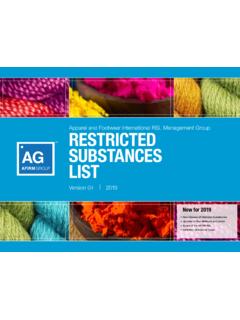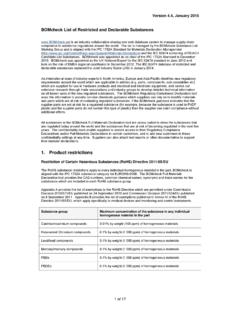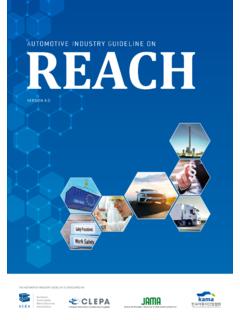Transcription of Why do we need REACH - European Commission
1 European Commission Environment Directorate General REACH in brief Why do we need REACH ? How does REACH work? What are the benefits and costs? What was the decision-making process? How will REACH be implemented? October 2007. 1. European Commission Environment Directorate General Table of contents 1. WHY DID WE NEED A NEW EU CHEMICALS POLICY?.. 3. THE PROBLEMS OF THE FORMER CHEMICALS LEGISLATION .. 3. THE OVERALL AIMS OF THE NEW CHEMICAL 4. 2. HOW DOES REACH WORK? .. 4. SCOPE .. 6. 6. Substances on their own or in 6. Substances in articles .. 9. DATA SHARING .. 10. INFORMATION IN THE SUPPLY CHAIN .. 10. DOWNSTREAM 11. 11. AUTHORISATION .. 12. 13. European CHEMICALS AGENCY (ECHA) .. 14. CLASSICATION AND LABELLING 14. ACCESS TO INFORMATION .. 15. 3. WHAT ARE THE COSTS AND BENEFITS?.. 15.
2 BENEFITS .. 15. COSTS .. 16. Direct Costs .. 16. Costs to Downstream Users .. 16. Total 17. Further work on impact assessment .. 17. 4. HISTORY OF THE DECISION MAKING PROCESS .. 17. 5. HOW WILL REACH BE IMPLEMENTED? .. 18. INTERIM STRATEGY .. 18. TRANSITIONAL AND IMPLEMENTING MEASURES .. 18. 6. MORE INFORMATION .. 19. 2. European Commission Environment Directorate General 1. WHY DID WE NEED A NEW EU CHEMICALS POLICY? THE PROBLEMS OF THE FORMER CHEMICALS LEGISLATION. The former EC legislative framework for chemical substances was a patchwork of many different Directives and Regulations which has developed historically. There were different rules for existing and new chemicals. However, this system did not produce sufficient information about the effects of the majority of existing chemicals on human health and the environment.
3 The identification and assessment of risks - covering the possible hazards of a substance as well as exposure of humans and the environment to it proved to be slow, as were the subsequent introduction of risk management measures. The former system hampered research and innovation, causing the EU chemicals industry to lag behind its counterparts in the US and Japan in this regard. The distinction, introduced under regulation (EC) 793/93, between so-called "existing" and "new". chemicals was based on the cut-off date of 1981. All chemicals that were reported as being on the European Community market between 1 January 1971 and 18 September 1981 (listed in the European Inventory of Existing Commercial Chemical Substances (EINECS)) were called "existing" chemicals. In 1981, they numbered more than different substances.
4 Chemicals introduced to the market after 1981 (more than 3800) were termed "new" chemicals. While new chemicals have to be tested before they are placed on the market, there were no such provisions for "existing" chemicals. Thus, although some information exists on the properties and uses of existing substances, there is generally a lack of sufficient information publicly available in order to assess and control these substances effectively. The pre- REACH allocation of responsibilities was also not appropriate: Public authorities were responsible for undertaking risk assessments of substances rather than the enterprises that manufacture, import or use the substances; and these risk assessments were required to be comprehensive, rather than targeted and use-specific. Since 1993, only 141 high-volume chemicals were identified as priority substances for risk assessment.
5 Recommendations for risk reduction were only available for a limited number of those chemicals for which the whole evaluation process under Regulation (EC) 793/93 has been completed. Furthermore, the former legislation required the manufacturers and importers of chemicals to provide information, but did not impose similar obligations on downstream users (industrial users and formulators) unless the substance had to be classified and a safety data sheet had to be supplied with it further down the supply chain. Thus, information on uses of substances was difficult to obtain and information about the exposure arising from downstream uses was generally scarce. On the other hand, new chemicals have to be notified and tested starting from volumes as low as 10. kg per year. This has been a barrier to innovation within the EU chemicals industry by discouraging research and invention of new substances and favouring the development and use of existing substances over new ones.
6 If an EU wide control is necessary, the pre- REACH process to restrict the marketing and use of substances has been very slow. It started in 1976 and restricted the marketing or use of only about 100 substances, including the use of some of them in articles, as well as the marketing to the general public of about 900 substances classified as carcinogenic, mutagenic or toxic to 3. European Commission Environment Directorate General reproduction (CMR substances). THE OVERALL AIMS OF THE NEW CHEMICAL STRATEGY. The two most important aims are to improve protection of human health and the environment from the risks of chemicals while enhancing the competitiveness of the EU chemicals industry. In the Strategy for a Future Chemicals Policy, published in 2001 (COM (2001) 88), the Commission outlined the result of a review of the pre- REACH system and laid the basis for a new strategy for ensuring a high level of chemicals safety and a competitive chemicals industry through a system for the Registration, Evaluation and Authorisation of Chemicals the REACH system.
7 The seven objectives that needed to be balanced within the overall framework of sustainable development were: Protection of human health and the environment Maintenance and enhancement of the competitiveness of the EU chemical industry Prevention of fragmentation of the internal market Increased transparency Integration with international efforts Promotion of non-animal testing Conformity with EU international obligations under the WTO. 2. HOW DOES REACH WORK? REACH is based on the idea that industry itself is best placed to ensure that the chemicals it manufactures and puts on the market in the EU do not adversely affect human health or the environment. This requires that industry has certain knowledge of the properties of its substances and manages potential risks. Authorities should focus their resources on ensuring industry are meeting their obligations and taking action on substances of very high concern or where there is a need for Community action.
8 REACH creates a single system for both existing and new substances; substances are now described as non-phase-in substances ( those not produced or marketed prior to the entry into force of REACH ) and phase-in substances (those substances listed in the EINECS, or those that have been manufactured in the Community, but not placed on the Community market, in the last 15. years or the so-called no longer polymers of Directive 67/548). Its basic elements are described below: 4. European Commission Environment Directorate General 1. All substances are covered by the REACH Regulation unless they are explicitly exempted from its scope. 2. Registration requires manufacturers and importers of chemicals to obtain relevant information on their substances and to use that data to manage them safely.
9 3. To reduce testing on vertebrate animals, data sharing is required for studies on such animals. For other tests, data sharing is required on request by other registrants. 4. Better information on hazards and risks and how to manage them safely will be passed down and up the supply chain. 5. Downstream users are brought into the system. 6. Evaluation is undertaken by the Agency for testing proposals made by industry or to check compliance with the registration requirements. The Agency co-ordinates substance evaluation by the authorities to investigate chemicals with perceived risks. This assessment may be used later to prepare proposals for restrictions or authorisation. 7. Substances with properties of very high concern will be made subject to authorisation; the Agency will publish a list containing such candidate substances.
10 Applicants will have to demonstrate that risks associated with uses of these substances are adequately controlled or that the socio-economic benefits of their use outweigh the risks. Applicants must also analyse whether there are safer suitable alternative substances or technologies. If there are, they must prepare substitution plans, if not, they should provide information on research and development activities, if appropriate. The Commission may amend or withdraw any authorisation on review if suitable substitutes become available. 8. The restrictions provide a procedure to regulate that the manufacture, placing on the market or use of certain dangerous substances shall be either subject to conditions or prohibited. Thus, restrictions act as a safety net to manage Community wide risks that are otherwise not adequately controlled.


















